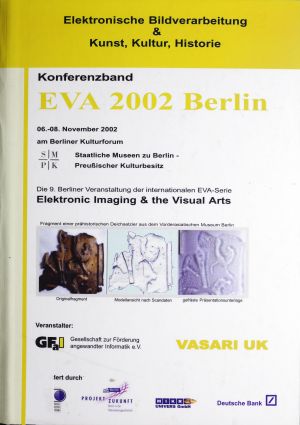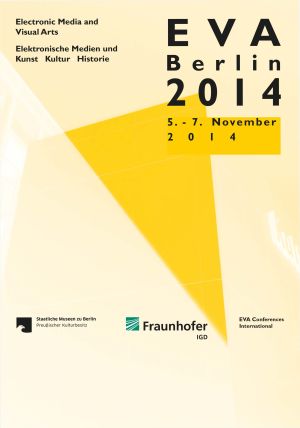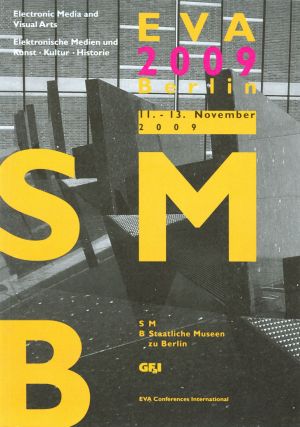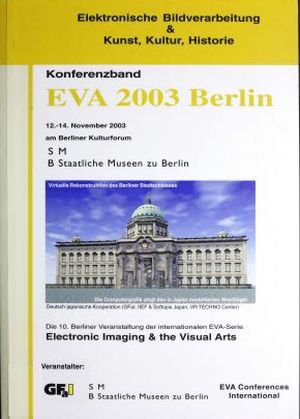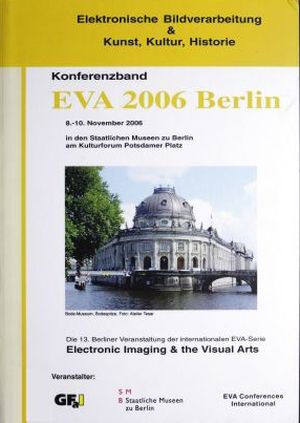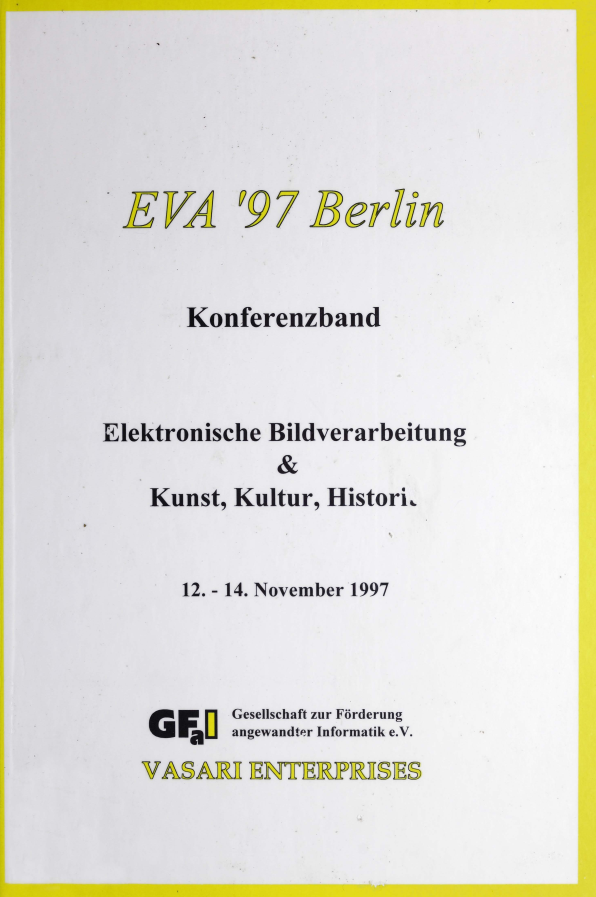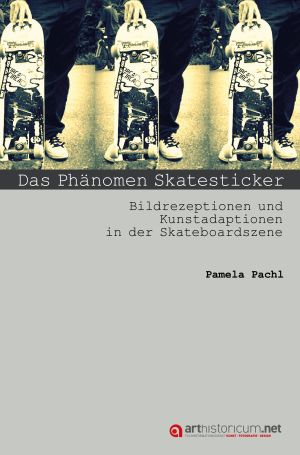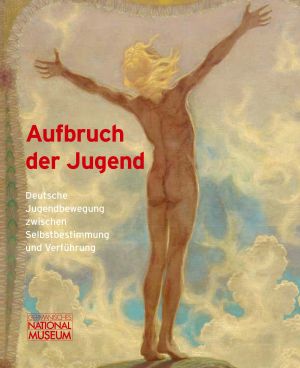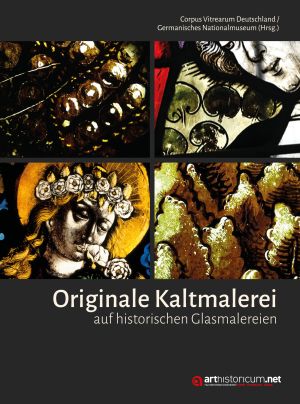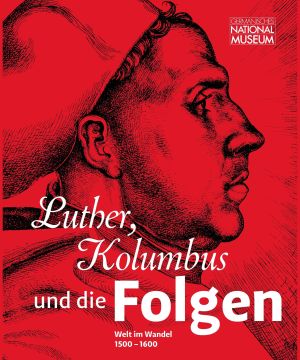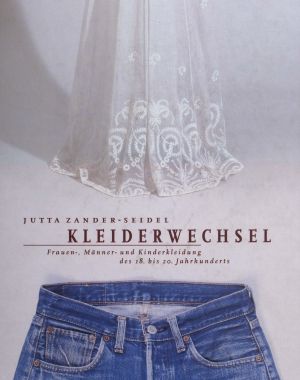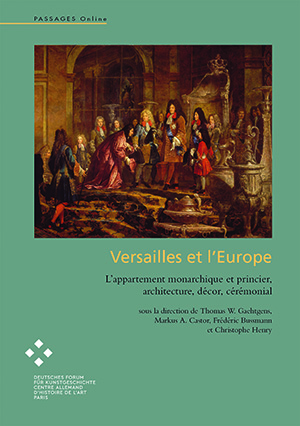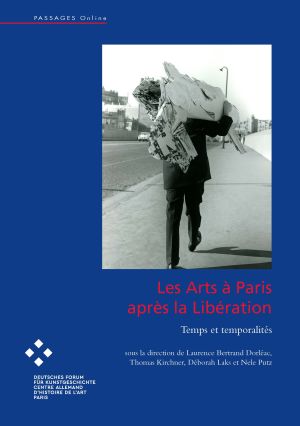Books
Konferenzband EVA Berlin 2015. Elektronische Medien & Kunst, Kultur und Historie: 22. Berliner Veranstaltung der internationalen EVA-Serie: Electronic Media and Visual Arts
Konferenzband EVA 2011 Berlin Elektronische Medien & Kunst, Kultur, Historie: Die 18. Berliner Veranstaltung der internationalen EVA-Serie Electronic Imaging & the Visual Arts (u. a. EVA London, EVA Florence, EVA Moscow & EVA Berlin)
Konferenzband EVA 2004 Berlin Elektronische Bildverarbeitung & Kunst, Kultur, Historie: Die 11. Berliner Veranstaltung der internationalen EVA-Serie Electronic Imaging & the Visual Arts (u.a. EVA London, EVA Florence, EVA Moscow & EVA Berlin)
Konferenzband EVA 2002. Berlin Elektronische Bildverarbeitung & Kunst, Kultur, Historie: Die 9. Berliner Veranstaltung der internationalen EVA-Serie Electronic Imaging & the Visual Arts (u.a. EVA London, EVA Florenz, EVA Moskau, EVA Gifu & EVA Berlin)
Konferenzband EVA 2001 Berlin Elektronische Bildverarbeitung & Kunst, Kultur, Historie: Die 8. Berliner Veranstaltung der internationalen EVA-Serie Electronic Imaging & the Visual Arts
Einige Aufsätze konnten wegen fehlender Einverständnisse der Autoren nicht online veröffentlicht werden.
Konferenzband EVA 2005 Berlin. Elektronische Bildverarbeitung & Kunst, Kultur, Historie: Die 12. Berliner Veranstaltung der internationalen EVA-Serie Electronic Imaging & the Visual Arts
Konferenzband EVA 2013 Berlin Elektronische Medien & Kunst, Kultur, Historie 6. - 8. November 2013 in den Staatlichen Museen zu Berlin am Kulturforum Potsdamer Platz: Die 20. Berliner Veranstaltung der internationalen EVA-Serie Electronic Imaging & the Visual Arts (u. a. EVA London, EVA Florence, EVA Moscow & EVA Berlin)
Zur Geschichte der Konstruktion von Sonnenuhren und Kompassen des 16. bis 18. Jahrhunderts
„Es gehört zu den Zielen dieser Veröffentlichungsreihe des Staatlichen Mathematisch Physikalischen Salons, nach Möglichkeit alle naturwissenschaftlich-technischen Fachgebiete, die mit dem Museum und seinen verschiedenartigen Sammlungen und mit der Forschungsstelle und ihren Aufgabenstellungen in Verbindung stehen, bei der Publikation neuer Forschungs- und Arbeitsergebnisse zu berücksichtigen.
Nachdem sich die ersten Bände ausführlich mit dem wohl bedeutendsten mathematischen Meßinstrument des 16.Jahrhunderts, dem „Quadratum geometricum" von CHR. SCHISSLER, und mit den ersten Forschungsergebnissen der Globusinventarisierung in der Deutschen Demokratischen Republik beschäftigt haben, wird heute eine Arbeit aus einem Teilgebiet der Chronometrie veröffentlicht. […]“ (Vorwort)
Le Chant du cygne: Die Gazette des Beaux-Arts und die französische Reproduktionsgraphik in der zweiten Hälfte des 19. Jahrhunderts
In his 1881 article about the Salon des Beaux-Arts, the critic Jules Buisson distinguished between the prints by the great engravers of the seventeenth and eighteenth centuries, which he referred to as “Chant du Triomphe”, and those of the late nineteenth century, which he characterized as “Chant du Cygne”. The latter term, the French for “swan song”, alludes unambiguously to the fact that printed reproductions of artworks – a genre by all means perceived as artistic – would soon be made obsolete by photographic methods.
This study of French reproduction prints is based on the Gazette des Beaux-Arts, an art magazine founded in 1859 and one of the most important of its kind in the nineteenth century. Reproduction prints were published in it until 1927, and original works of printmaking until 1933; printmaking was also the subject of numerous articles. The latter were concerned primarily with the expectations placed on printed reproductions, the assessment of individual prints and graphic artists, and – in view of the new photographic means of reproduction – the question of whether the “mere” reproduction of paintings and sculptures in the printmaking medium was to be considered an art form in its own right, and if so why.
Of the approximately 1,450 plates published in the Gazette until 1900, 64 reproduction prints were selected. The examination of these and other examples shows that, over the course of the good fifty years marking the transition from the manual to the photographic reproduction of art, there were two fundamental tendencies in the stylistic development. Initially the printmakers took as their orientation engraved reproductions of previous centuries as well as the painter-etcher medium, which underwent a revival in the 1840s. Later many of them developed a reproduction style clearly influenced by photography.
Konferenzband EVA Berlin 2014. Elektronische Medien & Kunst, Kultur und Historie: 21. Berliner Veranstaltung der internationalen EVA-Serie: Electronic Media and Visual Arts
Konferenzband EVA 2009 Berlin Elektronische Medien & Kunst, Kultur, Historie: Die 16. Berliner Veranstaltung der internationalen EVA-Serie Electronic Imaging & the Visual Arts (u. a. EVA London, EVA Florence, EVA Moscow & EVA Berlin)
Konferenzband EVA 2003 Berlin. Elektronische Bildverarbeitung & Kunst, Kultur, Historie: Die 10. Berliner Veranstaltung der internationalen EVA-Serie Electronic imaging & the Visual Arts (u.a. EVA London, EVA Florence, EVA Moscow & EVA Berlin)
Konferenzband EVA 2006 Berlin. Elektronische Bildverarbeitung & Kunst, Kultur, Historie: Die 13. Berliner Veranstaltung der internationalen EVA-Serie Electronic Imaging & the Visual Arts
Konferenzband EVA 2007 Berlin. Elektronische Bildverarbeitung & Kunst, Kultur, Historie: Die 14. Berliner Veranstaltung der internationalen EVA-Serie Electronic Imaging & the Visual Arts
EVA '97 Berlin. Konferenzband Elektronische Bildverarbeitung & Kunst, Kultur, Historie: die 4. Berliner Veranstaltung der EVA-Serie Electronic Imaging & the Visual Arts
Das Phänomen Skatesticker: Bildrezeptionen und Kunstadaptionen in der Skateboardszene
Skatestickers are graphically designed stickers distributed by skate labels (manufacturers of skateboards and accessories). Originally, they were produced for advertising purposes only, but have now become icons for the scene: “the visual expression of a lifestyle”, “the visual imprint of our feelings”, “a simple way of demonstrating the identification with a group”. Skaters collect, trade and value these stickers. Our visual research approach allows us to analyse and recognise the complex image motifs, which often adapt the visual arts, in these graphic design items and their increasingly autonomous function as visual media for a scene.
Aufbruch der Jugend: Deutsche Jugendbewegung zwischen Selbstbestimmung und Verführung
Accompanying the exhibition of the same title ("Aufbruch der Jugend - Deutsche Jugendbewegung zwischen Selbstbestimmung und Verführung") in the Germanisches Nationalmuseum from 26 September 2013 until 19 January 2014.
In the time around 1900, “youth” was synonymous with awakening and renewal, future and visions. Young middle-class people were challenging their elders. Many of the aims of these young people were met by the demands of the Lebensreform movement. Many young people joined organisations like “Wandervogel”, joint activities strengthening a sense of belonging.
In 35 critical essays and illustrated by 280 objects this volume depicts the youth movement from its beginnings, its political ideologisation, until the FRG’s first open-air festival in Schloss Waldeck in 1964.
Originale Kaltmalerei auf historischen Glasmalereien: Beiträge des Arbeitsgesprächs vom 10./11. März 2016 im Germanischen Nationalmuseum
The phenomenon of 'cold paint', that is, unfired painting on medieval and early modern glass paintings, has only recently come into the focus of restoration and research. In March 2016, a workshop organized by the National Committee of the Corpus Vitrearum Germany together with the Germanisches Nationalmuseum Nürnberg was dedicated to this topic. The presentations and lectures are now available in published form.
Das Sehbare und das Unsehbare: Abenteuer der Bildanschauung. Théodore Géricault, Frank Stella, Anselm Kiefer
If works of art are looked at really intensively, then visual perception will become an incomparable adventure. Then one immerses in their phenomenal world and in the intrinsic reality of painting. Only then also the genuine potential of the pictures will be seen. In three detailed chapters, a receptive-aesthetic-phenomenological journey through magnificent picture landscapes is undertaken.
In Théodore Géricault's Raft of the Medusa, it is important to follow the dynamic visual experience and the complex formations that disclose the work‘s previously unseen dimensions of meaning.The hunt for Moby Dick is once again painted by Frank Stella. Everything revolves around the question: how can his non-representational works follow Melville's novel, if the story itself already deals with the impossibility of narration? The pictorial landscape unfolded by Anselm Kiefer in his history painting Varus requires an entrance into the founding myth of the Hermannsschlacht. Here, one encounters not only a detailed genealogy of patriotic thinking developed in a picture-logical manner – but also the fractures and instabilities and the apocalyptic consequences of this German narration.It is always about what is visible to the eye and about what remains invisible but yet is indispensable.
Luther, Kolumbus und die Folgen: Welt im Wandel 1500-1600
Mit den Namen Luther und Kolumbus verbinden sich heute meist Vorstellungen von Aufbruch, Expansion und Glaubensfreiheit. Ausstellung und Katalog fragen anlässlich des 500. Reformationsjubiläums nach den Folgen der Gleichzeitigkeit von Glaubens- und Weltbildwandel im 16. Jahrhundert. Wie konnte eine sich auf die Autorität des Alten berufende Gesellschaft mit dem Veränderungsdruck ihrer Zeit umgehen? Ein 185 Nummern umfassender, reich illustrierter Katalog und sieben wissenschaftliche Beiträge beleuchten eine faszinierende Welt im Wandel, in der Aufbruchs-und Endzeitstimmung gleichermaßen ihren Platz hatten und der Umgang mit Neuem und Fremdem erst erprobt werden musste.
Kleiderwechsel: Frauen-, Männer- und Kinderkleidung des 18. bis 20. Jahrhunderts
Die Schausammlungen des Germanischen Nationalmuseums, Band 1
Die Neukonzeption der Schausammlung »Kleidung des 18. bis 20. Jahrhunderts« konnte 2002 mit einer feierlichen Eröffnung abgeschlossen werden. Die neue Dauerausstellung der Kostümsammlung führt durch 300 Jahre Kleidungskultur. Da sie nicht nur den Wandel der Kleider und Moden zeigt, sondern auch inhaltlich und ausstellungstechnisch auf neuen Grundlagen beruht, trägt sie den Titel »Kleiderwechsel«. Die Kostümsammlung des Germanischen Nationalmuseums gehört zu den ältesten textilen Fachsammlungen. Begleitet wird die Ausstellung vom ersten Band einer Publikationsreihe, mit der das Germanische Nationalmuseum seine neu eingerichteten Schausammlungen erschließt.
Friedrich Albert Schmidt, 1846–1916: Landschaftsmaler Weimarer Malerschule – Biographie und Werkverzeichnis
Third, completely revised edition 2018.
Friedrich Albert Schmidt, 1846–1916, belonged to the Weimar school of painters during the end phase of Realism and the transition to Impressionism. After studying art in Munich with Anschütz and Diez, the most formative years for his painting career resulted from his apprenticeship with Eugène Lavieille and his artistic friends in Barbizon, which was followed by more than five years with Arnold Böcklin in Florence. The influence of both masters can be seen clearly in his Weimar paintings and this influence continued well beyond the turn of the century. Schmidt reveals an impressive diversity in his artistic work which can be attributed to his various life phases and their associated painting periods, and which is also reflected in his choice of his tools. These range from large format oil paintings of studio work, up to paintings of medium and small sized formats from outdoor work, as well as etchings, watercolors and drawings in ink.
This presentation on the life of the German landscape painter Friedrich Albert Schmidt came from the desire to present an updated biography of the artist, along with images of his artistic work. Although he was well known and highly esteemed during his lifetime, today only a small group of art lovers of 19th Century landscape painting are familiar with his work. It is therefore the author’s objective to revive his work and communicate it to the current generation. Bearing this in mind, the presentation will primarily concentrate on documenting the formative stages of the artist’s life and his artistic painting periods. This third, completely revised edition of "Biography and painting register" 2018 records the latest insights about the artist and his work.
Friedrich Albert Schmidt is the great great uncle of the author.
Business Artists. Strategische Vermarkter im Kunstbetrieb: Andy Warhol - Damien Hirst - Jeff Koons - Takashi Murakami
Since not many decades a new type of artist has evolved, whose sole existence can be understood as another symptom of a total economisation of all areas of life: the business artist. He is an entrepreneur and manager, art director and designer. He organizes his production highly economic and delegates all work to his numerous assistants. He has become a global brand and strategically controls all marketing efforts. As an Art Star he stages his image and merges with global luxury brands.
In the tradition of Andy Warhol, Damien Hirst, Jeff Koons and Takashi Murakami are the three most successful business artists of our time are chosen, who represent this type of artist at best within the actual discourse.
Versailles et l'Europe: L’appartement monarchique et princier, architecture, décor, cérémonial
The volume presented here examines the influence of one of the most splendidly representative achievements of the early modern period upon the European courts of the 17th and 18th centuries. The Palace of Versailles was a showroom which made French luxury items known, and desired, far beyond the borders of France, drawing the attention of all regents of the time, and although numerous forms and ideas were borrowed by the artists and craftsmen who settled in the various European courts, the persistence of local traditions should not be under-estimated.
Starting with an analysis of the form and function of the Versailles apartments, the French model is considered for its influence upon the concept of the apartment at other European courts. The contributions to this volume analyse the interplay between architecture, décor and ceremony and the particular importance of the apartments for the representation of the court. The arrangement of the rooms is shown to be a complex referral system that decided the presentation of power and accessibility to the regent. The rationale of the interior design is only revealed through an interdisciplinary examination which also takes into consideration the social and political/historical conditions. Already existing traditions of the European houses were transferred and adapted, and therefore newly configured, as part of this process.
The first part of the volume concentrates on the model of the apartment developed in France and attempts an understanding of the complex development in Versailles up to 1701, within which the Chambre de Parade became the centrepiece of the Palace. The second part contains case studies of residences in the German-speaking countries and examines the complex exchange and variety of the heterogeneous solutions. The study concludes with contributions about various important European courts in England, Holland, Sweden, Poland, Spain and Italy.
__________
Le présent volume trouve son origine dans un projet aussi légitime qu’attendu : étudier l’influence sur les autres cours européennes de celle qui fut la plus brillante d’entre elles. Le château de Versailles, « showroom » étincelant contribuant à l’exportation des biens luxueux de la culture française hors des frontières, était au centre de tous les regards européens. Si des artistes et artisans français partis s’installer dans les pays germanophones empruntèrent nombre de ses formes et idées, sous-estimer la persistance des traditions locales serait néanmoins une erreur.
Analysant la forme et la fonction de l’appartement royal du château de Versailles, cet ouvrage examine sa portée en tant que modèle de référence pour les conceptions ultérieures d’appartements princiers en Europe. Le livre rassemble des travaux relatifs à l’architecture, à la décoration et au cérémonial des appartements des résidences royales et princières en Europe. L’accent est mis sur leur rôle spécifique dans le cérémonial de la cour. Dans cette perspective, l’effet conjoint de la disposition spatiale, de l’architecture et de la décoration apparaît comme un facteur complexe, influençant de manière considérable la mise en scène du pouvoir monarchique, la fonction de représentation du souverain et son accessibilité. C’est l’articulation interdisciplinaire des différents types de savoir qui permet de comprendre la logique d’aménagement des appartements des cours européennes, ainsi que leur usage et l’étiquette qui les gouvernait. Les traditions préexistantes des maisons européennes se voient repositionnées dans ce processus.
La première partie de cet ouvrage se concentre sur les appartements officiels français, qui, en tant que principal lieu à la mode au XVIIIe siècle, disposaient d’un important pouvoir d’attraction. Les premières contributions s’attachent surtout à présenter l’évolution complexe de l’appartement officiel du château de Versailles, des origines jusqu’en 1701, lorsque la chambre de parade devient le cœur architectural du château. La deuxième partie de l’ouvrage se consacre aux résidences du Saint Empire romain germanique. Le champ d’investigation s’étend enfin aux principales cours de Grande-Bretagne, des Pays-Bas, de Suède, de Pologne, d’Espagne et d’Italie. Les exemples analysés donnent un aperçu des échanges complexes et hétérogènes entre les cours européennes.
Les Arts à Paris après la Libération: Temps et Temporalités
The volume sheds new light on the Parisian art world after the Second World War, its protagonists, inter(national) dimensions and aesthetic challenges. It assembles a selection of contributions of the annual congress 2014/15 held at the German Center for Art History Paris as well as further results of research undertaken during that same year. Besides questions of historiography the publication focuses on case studies in which renowned artists like Giacometti, Picasso and Brassaï are analized. Furthermore, new protagonists, institutions and media are introduced and innovative perspectives developed. The volume thus makes a valuable contribution to the reevaluation of art of the postwar period.






